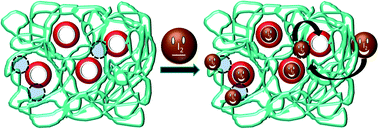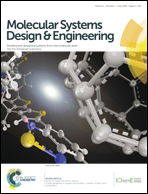Capture and immobilisation of iodine (I2) utilising polymer-based ZIF-8 nanocomposite membranes†
Abstract
Polymer nanocomposites made up of nanoporous metal–organic frameworks (MOFs) are fast becoming a staple of next generation hybrid composites, and are currently being intensely developed for gas capture and separation. This work reports the first attempt to capture and retain iodine (I2) using polymer-MOF (ZIF-8) nanocomposites. Membranes of ZIF-8-based nanocomposites (comprising either a glassy Matrimid or a rubbery polyurethane (PU) matrix) were prepared via a colloidal-mixing approach and their viability for I2 capture and retention effects was determined through absorption experiments, nanoindentation mechanical measurements, and thermogravimetric (TGA) analysis. The absorption experiments demonstrated that I2 capture and retention is possible in all of the nanocomposite membranes, although the PU/ZIF-8 30 wt% nanocomposite exhibited higher affinity for I2 absorption (>32 wt%). It is reasoned that the molecular affinity and attraction between I2, (2-methylimidazolate organic ligands of) ZIF-8 nanoparticles, and polymer matrices (Matrimid and PU) will catalyse the formation of weak secondary bonds, resulting in the ‘capture’ and ‘retention’ of I2 within molecular segments of the polymers and inside the pores of ZIF-8. The enhancement of the Young's modulus (E) of the PU/ZIF-8 30 wt% nanocomposite (E increased by ∼6%) is postulated to be due to I2 rigidification, while TGA analysis proved that I2 retention within both free volume of the polymer and ZIF-8 sodalite cages remained intact up till the points of structural degradation, at ∼200 °C for the PU-based nanocomposites, and at ∼300 °C for the Matrimid-based nanocomposites. We propose that the affinity of the organic ligands in ZIF-8 and the formation of free volume in the nanocomposites from the presence of ZIF-8 attracted I2, and the formation of secondary bonds between these constituents (H-bonds) strengthened not only the nanocomposite, but also kept I2 from being released despite the larger pore size and gate-opening dynamics of ZIF-8. It was therefore concluded that a combination of nanoparticles of porous MOFs and a rubbery polymer is promising for further development to enable I2 capture and retention applications.


 Please wait while we load your content...
Please wait while we load your content...